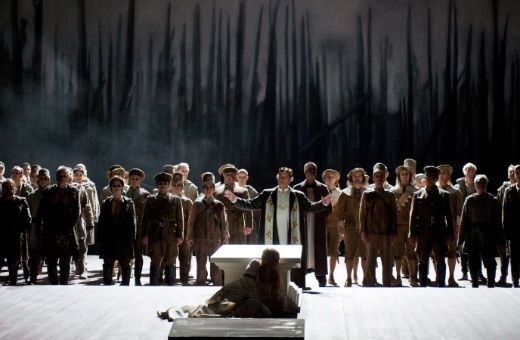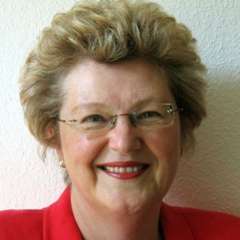Kasper Holten's production of Lohengrin for Deutsche Oper Berlin is now almost ten years old and has been revived several times with different casts. In its current iteration, no soloists remain from the premiere outing, and it shows in the degree of emotional and acting intensity – or lack of it.

Holten's Lohengrin is set in an undefined time and place, with no patriotic or national identification marks. Only the fact that this society is readying itself for a retaliatory battle is evident: during the Vorspiel, the stage is littered with grey, nondescript corpses and war widows looking for their loved ones. This battle, by and against whomever, has been lost. When the show curtain is lowered with its urban art lettering of Lohengrin, it denotes a sign of hope arising from the ashes. Now the men, still sporting their blood-stained uniforms, referencing them back to World War 1, accuse Elsa of murdering her brother Gottfried. Ortrud eggs on the men, including King Heinrich, even putting her hands on the sword that will decapitate Elsa in the next instant. She is saved by the appearance of a knight with over-dimensional swan wings, clad brilliantly in white. It is Lohengrin, who immediately frees Elsa from her blindfold and shackles. Elsa is more frightened than delighted by the sight of him. This Lohengrin has his own agenda, quickly looking through prompt cards to decide which story he is going to tell these people, just as much as he uses dazzling light and fog to take his opponent Telramund by surprise in the initial duel to save Elsa's honour.
Quite apart from Ortrud putting her on to it, it is no wonder Elsa cannot but ask this stranger – who looks like a cartoon of the angel Gabriel depicted in Renaissance paintings and takes off his wings in the bridal chamber – where he comes from and what his real identity is. Telramund is also fooled by the undressed wings as he enters the bridal chamber and goes for them, thus making it an easy game for Lohengrin to slay him. For experienced Lohengrin visitors, the big question is how the stage director will end the opera. In this version, Elsa was in fact guilty and produces her brother's corpse, with Lohengrin raising his fist in a Communist salute, ready to lead this ragged lot of soldiers to the next battle.
Although no announcement was made, it was clear that tenor David Butt Philip was indisposed. His portrayal suffered through the evening, despite the splendid swan wings. Jennifer Davis as Elsa was a pallid damsel, torn hither and thither between Lohengrin, King Heinrich and Ortrud. Interestingly, the timbre of her voice was similar to Iréne Theorin (Ortrud) – they could have been vocal sisters. Theorin lacked the scheming and the beguiling vocal quality that truly makes a great Ortrud. Baritone Jordan Shanahan gave his Telramund the dark and submissive shape that this character requires. Estonian bass Ain Anger embodied King Heinrich with regal authority and an elegant mellow sound. Australian baritone Samuel Dale Johnson made a handsome Herald with crystal clear diction. The chorus and extra chorus of the Deutsche Oper Berlin, rehearsed by Jeremy Bines, rightly receive emphatic cheers.
Sir Donald Runnicles loves the music of Richard Wagner, and it shows. Music Director at the Deutsche Oper since 2009, he has worked extensively on Wagner with his orchestra, having recently finished two rounds of the complete Ring. His Lohengrin offered an energetic and highly contrasting musical direction. Just as in a suspense thriller, Runnicles held his audience's attention with the inner dynamic inherent in the score. Special mention to the magnificently differentiated brass players, culminating in an impressive, quadraphonic sound from the high proscenium boxes.
For a city such as Berlin, with its three opera houses and Wagner always being a part of the repertoire, this was a fine but undistinguished performance of an audience favourite.


